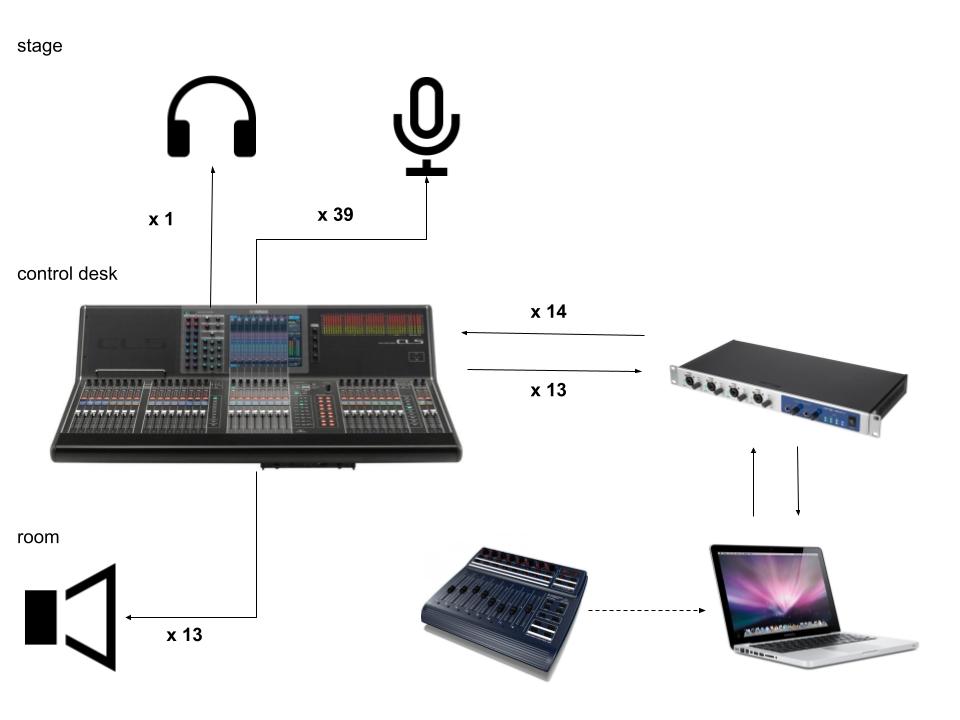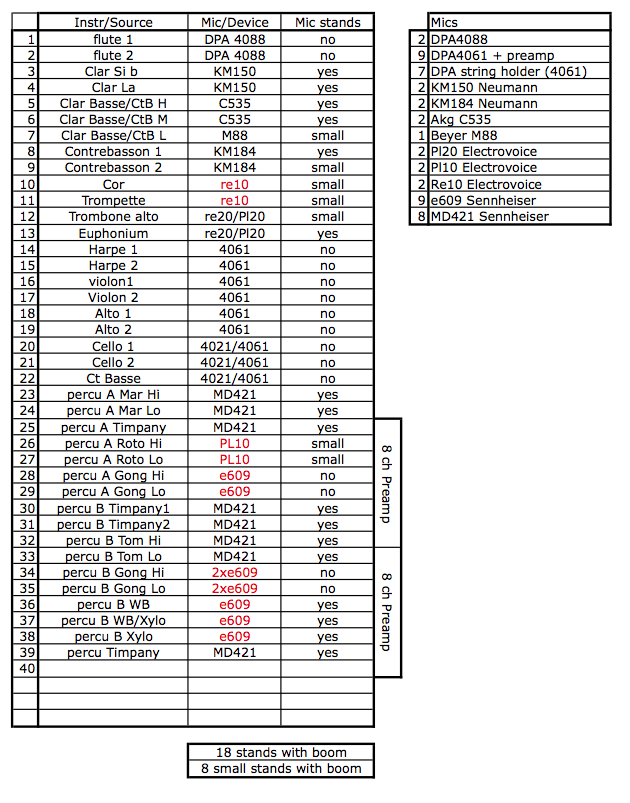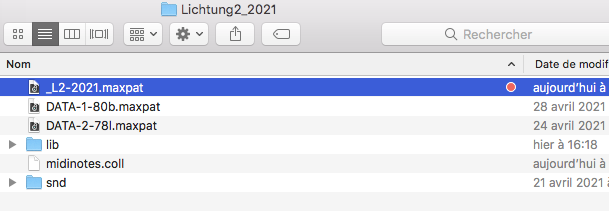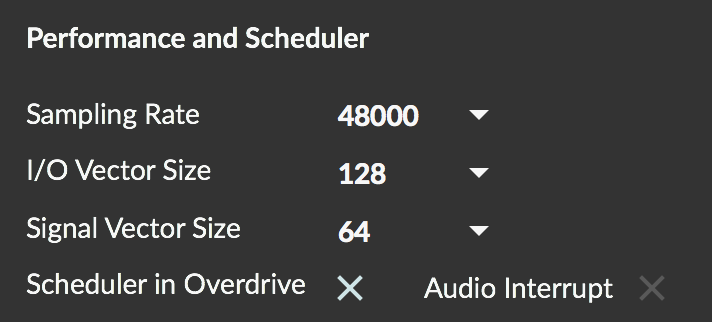Table of contents
Performance date: 8 septembre 2007
Documentation date: 20 mai 2021
Version state
Valid
Validation date: 9 décembre 2021
Executions dates of this version
- 8 septembre 2007,
Version documentalist
- svidzinski (Joao.Svidzinski@ircam.fr)
Version realisation
- Emmanuel Nunes (Composer)
- Eric Daubresse (Computer Music Designer)
Upgrade Motivation
2021 port (Max8 64bit with 48Khz SR) of the 2004 version
Other version(s)
Detailed staff
- 2 clarinettes, clarinette basse, cor, trombone, tuba (aussi euphonium), 4 percussionnistes, harpe, cordes, violon, alto, violoncelle, contrebasse
Channel details
- Number of input channel : 13
- Number of output channel : 14
Electronic equipment list
Computer Music Equipment
-
1 MacBook Pro - Apple Laptops
(Apple)
-
1 Max 8 - Max
(Cycling74)
-
1 Fireface 802 - Sound Board
(RME)
-
1 MIDI Mixer - MIDI Mixer
Audio Equipment
-
14 Loudspeaker - Loudspeakers
Work related information
Premiere
- 16 mai 1996, création partielle : Portugal, Lisbonne, vingtièmes rencontres Gulbenkian de musique contemporaine
- 22 juin 2000, création intégrale : France, Paris
Publisher :
- Ricordi
Realisation
- Eric Daubresse
- Ipke Starke
Work length
- 31 mn
Useful links on Brahms
- Lichtung II pour ensemble et électronique live (1995-2000), 31mn
- Emmanuel Nunes
| File | Author(s) | Comment | |
|---|---|---|---|
| Download [100,1 Mio] | Score L2-Score | Ricordi | |
| Download [1,2 Gio] | Simulation files L2-Simulation | WARNING !! The simulation sound files are only for testing. These are not real recordings.They were generated with virtual instruments from the midi file. Some differences with the the score may happen. | |
| Download [627,6 Kio] | Simulation files Midi files | ||
| Download [201,1 Mio] | Patch L2-Patch |
Instructions
Audio and MIDI setup

Loudspeaker setup



Midi setup
Use BCF-2000 or Lemur to control levels of treatment (change the “Midi device” in the main patch).
Sliders:
- Control 1 [ctlin 7 1] = Direct level in dB
- Control 2 [ctlin 7 2] = Frequency Shifter level
- Control 3 [ctlin 7 3] = Harmonizer 0 1 2 level
- Control 4 [ctlin 7 4] = Harmonizer 3 and FFT level in dB
- Control 5 [ctlin 7 5] = = Filters and reverb level in dB
- Control 6 [ctlin 7 6] = Synthesis level in dB
- Control 7 [ctlin 7 7] = Factorization envelopes length (1 normal length, 2 two times longer, 0.5 two times shorter)
Software installation
- Download L2-Patch.dmg and L2-Simulation.dmg files.
- In Max 8, choose …/Lichtung2_2021 in option > File preferences
- Check the Audio status in option > Audio Status:
- Close max and open _L2-2021.maxpat (red label)

DSP status

Patch presentation
The concert patch layout, as well as the DSP and control system, are based on the original version. The orignal patchs have been put together in a single patch.

The DSP patch is accessible in the [patcher DSP~], at the left, just bellow “OUT LEVELS”
The two control system are in the middle [DATA-1-80b] and [DATA-2-78].
DSP engine
The DSP part consists of ring modulation, frequency shifter, harmonizer, reverb and FFT. They are based on the original version.
See the Eric Daubresse’s document for more information regarding DSP and spatialization.
http://brahms.ircam.fr/media/uploads/EN_L_92-FR.pdf
Spatialization
Sounds are fixed or they move using rhythmic movements.
Movements are controlled by patchs called circuit, BNP and lope. Rhythms are controlled by the patcher generation. The three ways of moving can be used at the same time.
The sound envelope could be controlled with the fader “Factorization envelopes length” which controls factorization of the envelope duration. The bigger superfac is, the longer will be the sound envelope in each HP.
See the Eric Daubresse’s document for more information regarding spatialization.
http://brahms.ircam.fr/media/files/2021/05/24/Lichtungen-eric.pdf
System calibration and tests
- Follow the Initialization routine (see it bellow).
- Check the DSP status.
- Check the Midi controller input.
- Adjust the instruments input level.
- Listen to the spatialisation. If the sound which goes from one to another HP is too long, decrease the superfactor. However, if you have holes of sound when the sound goes from an HP to another, increase the superfactor (see patch presentation, spatialization above for more details).
Simulation system
The simulation files could be used to test the setup before the rehearsal.
- download L2-Simulation .
- open L2-Simulation.maxpat.
- Use it as a simulation of the adc mic input (the [r go] button in the main patch is synchronized with Simulation Patch).
WARNING !!
The simulation sound files are only for testing. They are not real recordings. It was generated with virtual instruments from the midi file. Some differences with the the score may happen.
Initialization routine
Check all the points explained in the main patch:
WARNING: Opening the main patch may take a long time due to the size of the file.
- Configure audio status (see DSP status above).
- Select the midi controller
- Press “init” and “reset bang” buttons.
- Turn on the DSP and midi.
- Set the section according to the score. In the case of playing from the beginning, set “1” by pressing message 1, just below “start”.
- Press “Go” button (it must be synchronized with the conductor).
All the events are trigged automatically. The conductor must follow the click track whose output is the Dac 13.
© IRCAM

This documentation is licensed under a Creative Commons Attribution-NonCommercial-NoDerivatives 4.0 International License.
Version documentation creation date: 20 mai 2021 16:42, update date: 27 juin 2022 08:47